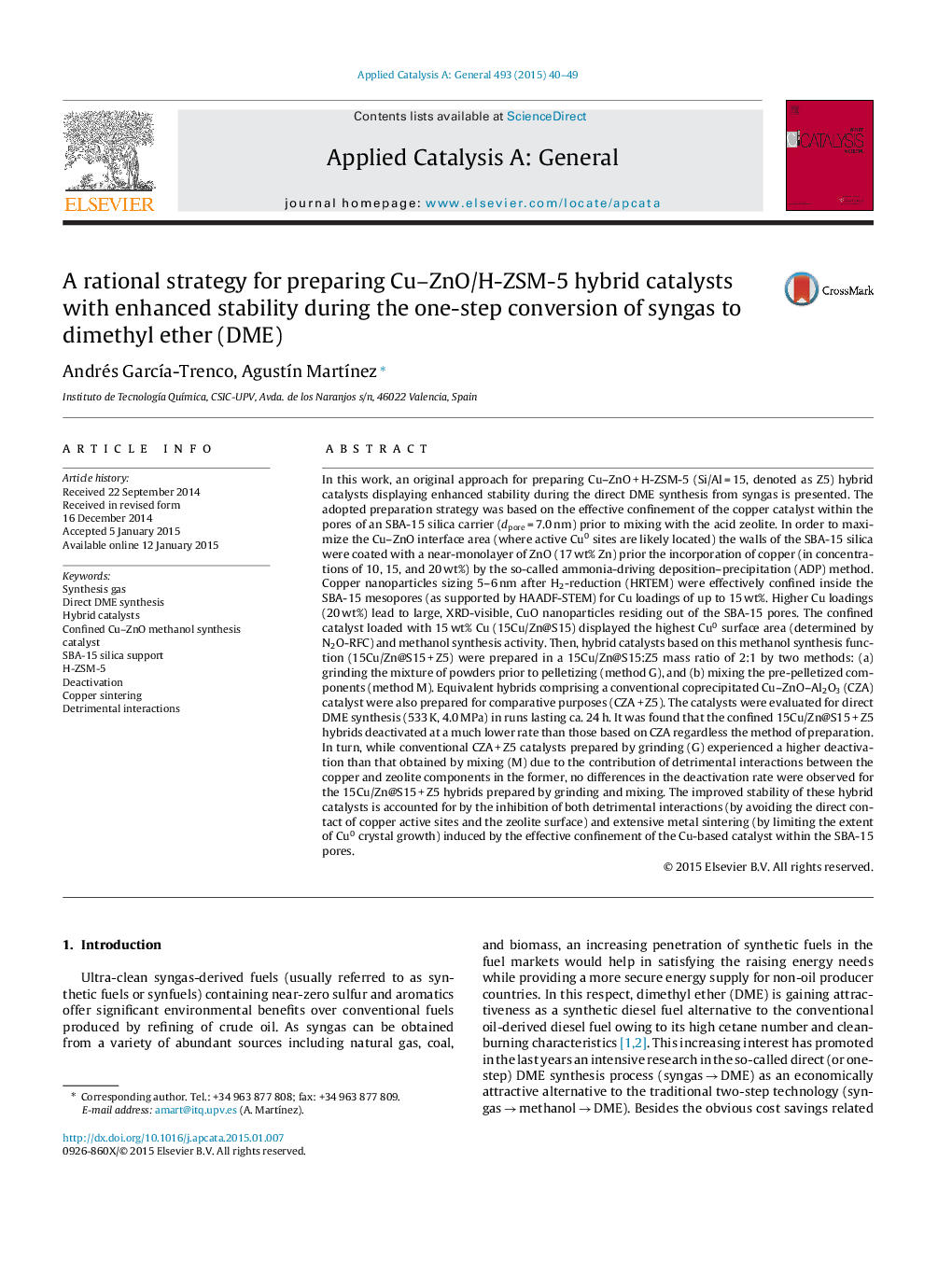| کد مقاله | کد نشریه | سال انتشار | مقاله انگلیسی | نسخه تمام متن |
|---|---|---|---|---|
| 39373 | 45821 | 2015 | 10 صفحه PDF | دانلود رایگان |

• Cu–ZnO methanol synthesis catalyst (MSC) is confined within the pores of SBA-15.
• Hybrid catalysts based on confined MSC are more stable for direct DME synthesis.
• Improved stability due to limited Cu sintering and lack of detrimental interactions.
In this work, an original approach for preparing Cu–ZnO + H-ZSM-5 (Si/Al = 15, denoted as Z5) hybrid catalysts displaying enhanced stability during the direct DME synthesis from syngas is presented. The adopted preparation strategy was based on the effective confinement of the copper catalyst within the pores of an SBA-15 silica carrier (dpore = 7.0 nm) prior to mixing with the acid zeolite. In order to maximize the Cu–ZnO interface area (where active Cu0 sites are likely located) the walls of the SBA-15 silica were coated with a near-monolayer of ZnO (17 wt% Zn) prior the incorporation of copper (in concentrations of 10, 15, and 20 wt%) by the so-called ammonia-driving deposition–precipitation (ADP) method. Copper nanoparticles sizing 5–6 nm after H2-reduction (HRTEM) were effectively confined inside the SBA-15 mesopores (as supported by HAADF-STEM) for Cu loadings of up to 15 wt%. Higher Cu loadings (20 wt%) lead to large, XRD-visible, CuO nanoparticles residing out of the SBA-15 pores. The confined catalyst loaded with 15 wt% Cu (15Cu/Zn@S15) displayed the highest Cu0 surface area (determined by N2O-RFC) and methanol synthesis activity. Then, hybrid catalysts based on this methanol synthesis function (15Cu/Zn@S15 + Z5) were prepared in a 15Cu/Zn@S15:Z5 mass ratio of 2:1 by two methods: (a) grinding the mixture of powders prior to pelletizing (method G), and (b) mixing the pre-pelletized components (method M). Equivalent hybrids comprising a conventional coprecipitated Cu–ZnO–Al2O3 (CZA) catalyst were also prepared for comparative purposes (CZA + Z5). The catalysts were evaluated for direct DME synthesis (533 K, 4.0 MPa) in runs lasting ca. 24 h. It was found that the confined 15Cu/Zn@S15 + Z5 hybrids deactivated at a much lower rate than those based on CZA regardless the method of preparation. In turn, while conventional CZA + Z5 catalysts prepared by grinding (G) experienced a higher deactivation than that obtained by mixing (M) due to the contribution of detrimental interactions between the copper and zeolite components in the former, no differences in the deactivation rate were observed for the 15Cu/Zn@S15 + Z5 hybrids prepared by grinding and mixing. The improved stability of these hybrid catalysts is accounted for by the inhibition of both detrimental interactions (by avoiding the direct contact of copper active sites and the zeolite surface) and extensive metal sintering (by limiting the extent of Cu0 crystal growth) induced by the effective confinement of the Cu-based catalyst within the SBA-15 pores.
Figure optionsDownload high-quality image (179 K)Download as PowerPoint slide
Journal: Applied Catalysis A: General - Volume 493, 5 March 2015, Pages 40–49